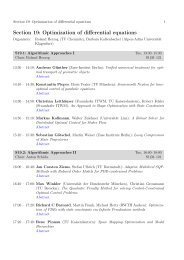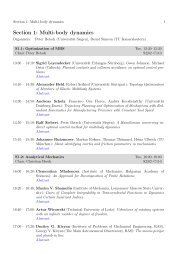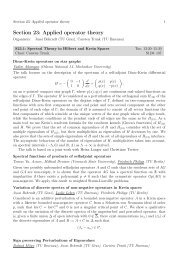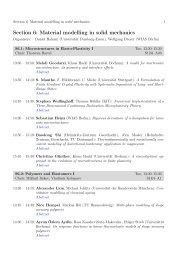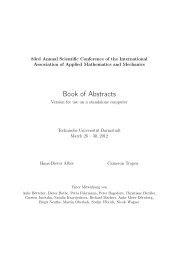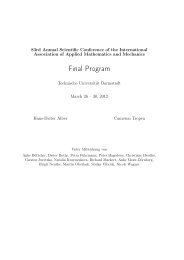Section 6: Material modelling in solid mechanics - GAMM 2012
Section 6: Material modelling in solid mechanics - GAMM 2012
Section 6: Material modelling in solid mechanics - GAMM 2012
You also want an ePaper? Increase the reach of your titles
YUMPU automatically turns print PDFs into web optimized ePapers that Google loves.
2 <strong>Section</strong> 6: <strong>Material</strong> <strong>modell<strong>in</strong>g</strong> <strong>in</strong> <strong>solid</strong> <strong>mechanics</strong><br />
and <strong>in</strong>cremental algorithmic variational pr<strong>in</strong>ciples. We demonstrate the model<strong>in</strong>g capabilities and<br />
algorithmic performance by means of representative numerical examples for multislip scenarios<br />
<strong>in</strong> fcc s<strong>in</strong>gle crystals.<br />
Numerical Implementation of a Three-Dimensional Cont<strong>in</strong>uum Dislocation Microplasticity<br />
Theory<br />
Stephan Wulf<strong>in</strong>ghoff, Thomas Böhlke (KIT)<br />
The <strong>modell<strong>in</strong>g</strong> of the mechanical behaviour of micro-devices can not be established by classical<br />
cont<strong>in</strong>uum mechanical plasticity models without <strong>in</strong>ternal length scale. Depend<strong>in</strong>g on the system<br />
size, ab-<strong>in</strong>itio simulations or Discrete Dislocation Dynamics serve as mature tools to predict the<br />
mechanical response of very small systems. Anyhow, the gap between these discrete and classical<br />
cont<strong>in</strong>uum mechanical methods is not yet filled. Besides phenomenological gradient plasticity<br />
models, dislocation density based approaches have emerged which account explicitly for dislocation<br />
transport and l<strong>in</strong>e length <strong>in</strong>crease. The presentation is based on the k<strong>in</strong>ematical cont<strong>in</strong>uum<br />
mechanical dislocation framework of Hochra<strong>in</strong>er et al. [1] which can be considered as a generalization<br />
of Nye’s theory [3]. The theory transfers the k<strong>in</strong>ematics of three-dimensional systems of<br />
discrete dislocations to a cont<strong>in</strong>uum mechanical representation <strong>in</strong> terms of cont<strong>in</strong>uously distributed<br />
dislocations. An averaged version of the theory by Hochra<strong>in</strong>er et al. [2] (see also Sandfeld et<br />
al. [4]) leads to a significant reduction of the computational simulation effords and will ma<strong>in</strong>ly<br />
be addressed. The k<strong>in</strong>ematical dislocation theory is coupled to a crystal plasticity framework.<br />
The presentation will focus on the numerical implementation of the theory, especially on promis<strong>in</strong>g<br />
schemes for the numerical coupl<strong>in</strong>g of the set of PDEs. F<strong>in</strong>ite Element simulation results<br />
demonstrate the performance of the implementation <strong>in</strong> three-dimensional applications.<br />
[1] T. Hochra<strong>in</strong>er, M. Zaiser and P. Gumbsch, A three-dimensional cont<strong>in</strong>uum theory of dislocations:<br />
k<strong>in</strong>ematics and mean field formulation. Philosophical Magaz<strong>in</strong>e 87 (2007), 1261–1282.<br />
[2] T. Hochra<strong>in</strong>er, M. Zaiser and P. Gumbsch, Dislocation transport and l<strong>in</strong>e length <strong>in</strong>crease <strong>in</strong><br />
averaged descriptions of dislocations. arXiv:1010.2884v1<br />
[3] J. F. Nye, Some geometrical relations <strong>in</strong> dislocated crystals. Acta Metallurgica 1 (1953),<br />
153–162.<br />
[4] S. Sandfeld, T. Hochra<strong>in</strong>er, M. Zaiser and P. Gumbsch, Cont<strong>in</strong>uum model<strong>in</strong>g of dislocation<br />
plasticity: Theory, numerical implementation, and validation by discrete dislocation<br />
simulations. J. Mater. Res. 26 (2011), 623–632.<br />
Rigorous derivation of a dissipation for lam<strong>in</strong>ate microstructures<br />
Sebastian He<strong>in</strong>z (WIAS Berl<strong>in</strong>)<br />
We study models for f<strong>in</strong>ite plasticity <strong>in</strong> the framework of rate-<strong>in</strong>dependent evolutionary systems.<br />
The correspond<strong>in</strong>g <strong>in</strong>cremental m<strong>in</strong>imization problems, <strong>in</strong> general, admit no solutions due to<br />
the creation of microstructure, see [1]. We focus on the case where the microstructure is made of<br />
simple lam<strong>in</strong>ates only. We show <strong>in</strong> a mathematical rigorous way how the <strong>in</strong>cremental m<strong>in</strong>imization<br />
problem can be relaxed and identify the relaxed dissipation as the one <strong>in</strong>troduced <strong>in</strong> [2].<br />
[1] C. Carstensen, K. Hackl, A. Mielke. Non-convex potentials and microstructures <strong>in</strong> f<strong>in</strong>ite-stra<strong>in</strong><br />
plasticity, Proc. Royal Soc. London, Ser. A 458 (2002), 299 – 317.



